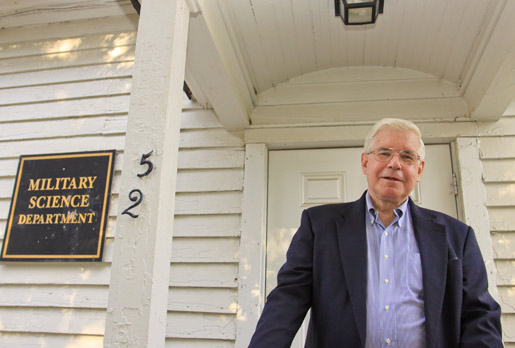English professor may have found nation’s oldest schoolhouse for black children
Terry L. Meyers, Chancellor Professor of English, has been featured in two national publications recently regarding research of the 18th century Bray School and its possible connection to an old house tucked on the edge of William & Mary’s campus.
The site, located on Prince George Street and now used by the College’s ROTC program, could be the nation’s oldest surviving schoolhouse for black children, free and enslaved, Meyers told The Washington Post in a July 23 feature article. Meyers was also featured in The Chronicle of Higher Education.
Meyers’s research indicates that the house may have been home to the Bray School, established in Williamsburg in 1760 on the recommendation of Benjamin Franklin by an English philanthropy, the Associates of Dr. Bray. The Rev. Thomas Bray was the commissary in Maryland of the bishop of London and a friend of James Blair, commissary in Virginia and founder of the College. Bray and the Associates advocated for the religious education of black and Indian children.
The research is timely. A committee of faculty, staff, students and community members is currently studying and exploring the role of race in the College’s history as part of the Lemon Project. The initiative, launched following a resolution in April 2009 by the William & Mary Board of Visitors, is a multiyear effort to better understand William & Mary’s own connections to slavery as well as race relations at the College from the end of the Civil War to date. The effort is named after a slave called Lemon whom the College owned in the early 18th century.
Terry L. Meyers, Chancellor Professor of English, has been featured in two national publications recently regarding research of the 18th century Bray School and its possible connection to an old house tucked on the edge of William & Mary’s campus.
The site, located on Prince George Street and now used by the College’s ROTC program, could be the nation’s oldest surviving schoolhouse for black children, free and enslaved, Meyers told The Washington Post in a July 23 feature article. Meyers was also featured in The Chronicle of Higher Education.
Meyers’s research indicates that the house may have been home to the Bray School, established in Williamsburg in 1760 on the recommendation of Benjamin Franklin by an English philanthropy, the Associates of Dr. Bray. The Rev. Thomas Bray was the commissary in Maryland of the bishop of London and a friend of James Blair, commissary in Virginia and founder of the College. Bray and the Associates advocated for the religious education of black and Indian children.
The research is timely. A committee of faculty, staff, students and community members is currently studying and exploring the role of race in the College’s history as part of the Lemon Project. The initiative, launched following a resolution in April 2009 by the William & Mary Board of Visitors, is a multiyear effort to better understand William & Mary’s own connections to slavery as well as race relations at the College from the end of the Civil War to date. The effort is named after a slave called Lemon whom the College owned in the early 18th century.![]()
















